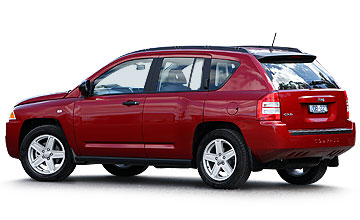BY BYRON MATHIOUDAKIS | 20th Mar 2007

But we think the really big news is that this is the US 4x4 firm’s first vehicle that steers with anything approaching sharpness and sporty agility.
Now we’re not suggesting BMW-standards of driver satisfaction from behind the Compass’ large steering wheel, or even Ford Focus levels of dynamic prowess.
However, if you are expecting another lumbering SUV, or even the somewhat data-detached tiller of, say, a Honda CR-V, then you are in for a pleasant surprise.
The Compass corners with the sort of élan that even its Dodge Caliber small-car sibling – which by definition ought to easily out-handle and out-manoeuvre it – cannot match.
Unbelievably, it remains as the car’s most lasting impression, overtaking even the fanciful Audi Quattro-esque blistered wheel-arches, the Alfa 156-style hidden rear-door handles and the bug-eyed Jeep face that in isolation are outrageously out of place but, as a whole, somehow manage to gel.
Identikit styling aside, the Compass – on first meeting at least – might be a better car than early overseas press reports suggest.
Okay, the interior’s trim materials conform to Jeep’s usual practice of feeling cheap and hard, and one car did suffer from an annoyingly persistent rattle, but this does not mean that the Compass’ cabin is not a nice place to be.
The easy to decipher and aesthetically inoffensive dashboard does its job admirably, as do the front seats.
Aided by reclining rear seatbacks, rear legroom is surprisingly roomy, equipment levels are extremely competitive (ESP stability control is included in all models some rivals don’t even offer it), and the leather trim in the up-spec Limited looks smart.
Cargo space probably trails that of some larger compact SUVs, and there is some road and engine noise coming into the cabin (especially in the diesel variant) but overall the Compass does begin to shape up well, especially if you enjoy quick responses.
The VW-sourced CRD turbo-diesel is the choice, with its strong mid-range torque for quick overtaking manoeuvres and relaxed highway cruising capabilities, and nicely spaced six forward gear ratios.
But it is an expensive option, adding an eye-watering $4000 to the price of the Compass 2.4 five-speed manual – and that’s without an automatic choice.
Currently, Compass sets itself apart from all other car-based compact SUVs by being the only one to offer turbo-diesel power one at the moment. It’s a good one too.
Yet there are arguments for settling for the 2.4-litre petrol-powered drivetrain.
It is very competitively priced, has adequate performance for most urban situations, and mates sufficiently well to the CVT automatic for owners to realise some efficiency savings compared to similarly-sized rivals using more conventional automatic gearboxes.
We found that, on the mountainous roads on which we sampled all three Compass drivetrains, the base manual’s positive gearshift action meant that we did not mind the frequent downchanges required to keep the 2.4-litre engine’s peaky performance on the boil.
Another surprise is how responsive and controllable the Compass is on unsealed roads, with only the occasional thump from one of the front wheels reminding us that this is a car-based, and not a heavy-duty truck-based SUV.
Jeep has set very modest sales targets, but we believe the Compass will have little trouble finding buyers, especially those who fancy something offbeat, involving to drive and without the mumsy soft-roader baggage personified by the majority of vehicles in this class.
Welcome the Compass then - a Jeep that cannot go where other Jeeps have no problem getting to, but will take the company to places the brand has never quite reached before – and that could include a keen driver’s shortlist of enjoyable compact SUVs.